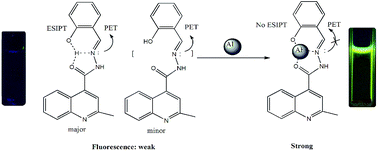Design and synthesis of a chemosensor for the detection of Al3+ based on ESIPT†
Abstract
In this study, a simple fluorescent sensor 2-hydroxybenzcarbaldehyde-(2-methylquinoline-4-formyl) hydrazone (HL) has been designed, synthesized and characterized by 1H-NMR, IR, ESI-MS. Upon addition of Al3+, HL shows a large fluorescence enhancement (220-fold) at 484 nm. The reasons for this phenomenon are attributed to formation of a 1 : 1 complex (Ka = 5.6 × 104), which inhibits the excited-state intramolecular proton transfer (ESIPT) process and photo-induced electron transfer (PET) process. Other metal ions including Ba2+, Ca2+, Cd2+, Co2+, Cr3+, Hg2+, K+, Mg2+, Mn2+, Na+, Ni2+, Pb2+ and Zn2+, have almost no influence on the fluorescence. The lowest detection limit for Al3+ is calculated to be 7.2 × 10−7 M in ethanol.


 Please wait while we load your content...
Please wait while we load your content...